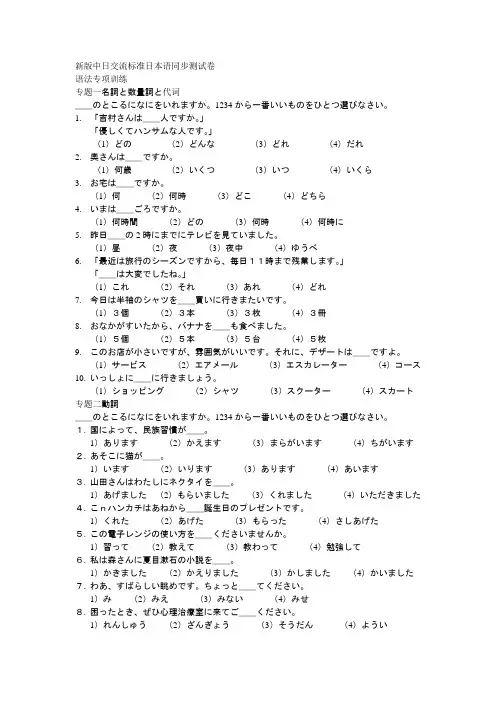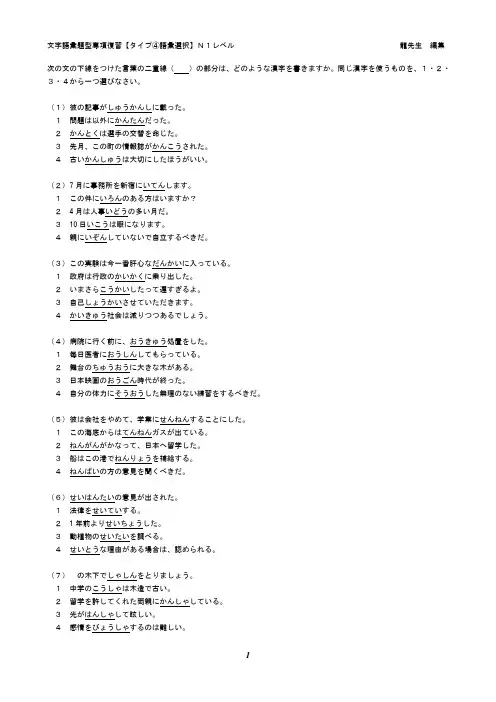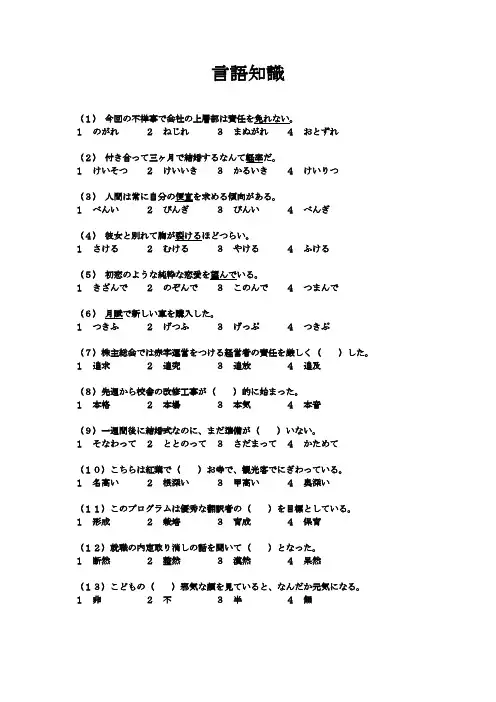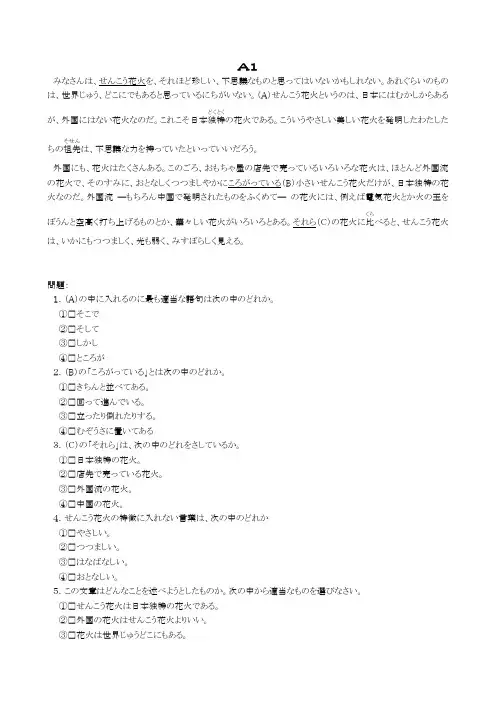新日本语能力考试N1语法强化训练145
日语N1文字词汇强化训练及详解(1-100)

もしくは(若しくは)
或,或者.
雨,若しくは雪になるでしょう/要下雨??甚至.
?ジ?の平和ひいては世界の平和に力をつくしたい/
愿为亚洲和平进而为世界和平〔或者下雪吧.
国電若しくは地下鉄が便利です/(国营)电车或者地铁方便.
2、趣味に熱中するあまり、仕事が▁▁▁▁になってしまった。
1おごそか
2おろそか
3なだらか
4なめらか
正确答案: 2おろそか
解释:句意:过于沉溺于爱好,把工作给疏忽了。
这组都是(形動)
厳か:おごそか 庄严,严肃;[態度が]肃穆;[言葉つきや挙動が]庄重,郑重. 厳かな態度/严肃的态度.
厳かに宣言する/郑重宣布.
1、小さな犯罪を取り締まることが、▁▁▁▁大きな犯罪を減らすことにつながるのだ。 1あるいは
2さほどは
3ひいては
4もしくは
正确答案: 3ひいては
解释:句意:取缔小犯罪与减少大犯罪是相关联的。
あるいは
或,或是,或者(同類の物事の中のどれか一つであることを表す)。
疎か:Байду номын сангаасろそか
疏忽,玩忽,不认真,马马虎虎,草率.
ペンあるいは筆/钢笔或是毛笔。
北京あるいは上海で開催する/在北京或上海举办。
さほどは(先程)
刚才,方才,刚过去不久.
彼は先程帰ったばかりです/他刚回去不久.
先程は失礼しました/方才失敬了; 方才对不起.
ひいては
进而',不但??而且,不仅不仅亚洲和平甚至愿为世界和平〕贡献力量.
新版中日交流标准日本语同步测试卷——语法专项训练

新版中日交流标准日本语同步测试卷语法专项训练专题一名詞と数量詞と代词__のとこるになにをいれますか。
1234から一番いいものをひとつ選びなさい。
1.「吉村さんは__人ですか。
」「優しくてハンサムな人です。
」(1)どの(2)どんな(3)どれ(4)だれ2.奥さんは__ですか。
(1)何歳(2)いくつ(3)いつ(4)いくら3.お宅は__ですか。
(1)何(2)何時(3)どこ(4)どちら4.いまは__ごろですか。
(1)何時間(2)どの(3)何時(4)何時に5.昨日__の2時にまでにテレビを見ていました。
(1)昼(2)夜(3)夜中(4)ゆうべ6.「最近は旅行のシーズンですから、毎日11時まで残業します。
」「__は大変でしたね。
」(1)これ(2)それ(3)あれ(4)どれ7.今日は半袖のシャツを__買いに行きまたいです。
(1)3個(2)3本(3)3枚(4)3冊8.おなかがすいたから、バナナを__も食べました。
(1)5個(2)5本(3)5台(4)5枚9.このお店が小さいですが、雰囲気がいいです。
それに、デザートは__ですよ。
(1)サービス(2)エアメール(3)エスカレーター(4)コース10.いっしょに__に行きましょう。
(1)ショッピング(2)シャツ(3)スクーター(4)スカート专题二動詞__のとこるになにをいれますか。
1234から一番いいものをひとつ選びなさい。
1.国によって、民族習慣が__。
1)あります(2)かえます(3)まらがいます(4)ちがいます2.あそこに猫が__。
1)います(2)いります(3)あります(4)あいます3.山田さんはわたしにネクタイを__。
1)あげました(2)もらいました(3)くれました(4)いただきました4.こnハンカチはあねから__誕生日のプレゼントです。
1)くれた(2)あげた(3)もらった(4)さしあげた5.この電子レンジの使い方を__くださいませんか。
1)習って(2)教えて(3)教わって(4)勉強して6.私は森さんに夏目漱石の小説を__。
蓝宝书新日本语能力考试N2文法145

蓝宝书新日本语能力考试N2文法145 本系列文章将侧重点放在了语法在句型的运用上面。
通过能力考真题等鲜活的例子来讲解句型的实际运用,突出了句型的核心用法以及在使用时的限制和注意点,使学习者在考试以及实际运用中避免出现似懂非懂、模棱两可的局面出现。
文法の部分
~ないことはない/ないこともない
接続名詞+ はもちろん/はもとより
説明表示“...自不必说”“不用说...”
例文★面接試験では、話し方はもちろん、服装などにも気をつける必要がある。
[面试时,说话方式就不用说了,着装也要注意]
★最近、日本では大学生はもちろん、小学生までパソコンを使うようになった。
[最近日本,大学生就不用说了,连小学生都开始用电脑了]
注意「はもとより」比「はもちろん」更书面化,前项是具有代表性的事物,后项是与前项同一范畴的其他事物,常常和「も/でも/まで」呼应使用。
翻訳の宿題:
★この製品は国内はもとより、海外でも高い評価を得ている。
这个产品在国内就不用说了,即使在海外也获得了很高的评价。
以上就是蓝宝书新日本语能力考试N2文法145的内容,本系列文章全面梳理,逼真演练,深度分析,直击考点,带您攻破日语N2大关!。
日本语能力考试一级N1词汇专项复习(题型4)

次の文の下線をつけた言葉の二重線()の部分は、どのような漢字を書きますか。
同じ漢字を使うものを、1・2・3・4から一つ選びなさい。
(1)彼の記事がしゅうかんしに載った。
1問題は以外にかんたんだった。
2かんとくは選手の交替を命じた。
3先月、この町の情報誌がかんこうされた。
4古いかんしゅうは大切にしたほうがいい。
(2)7月に事務所を新宿にいてんします。
1この件にいろんのある方はいますか?24月は人事いどうの多い月だ。
310日いこうは暇になります。
4親にいぞんしていないで自立するべきだ。
(3)この実験は今一番肝心なだんかいに入っている。
1政府は行政のかいかくに乗り出した。
2いまさらこうかいしたって遅すぎるよ。
3自己しょうかいさせていただきます。
4かいきゅう社会は減りつつあるでしょう。
(4)病院に行く前に、おうきゅう処置をした。
1毎日医者におうしんしてもらっている。
2舞台のちゅうおうに大きな木がある。
3日本映画のおうごん時代が終った。
4自分の体力にそうおうした無理のない練習をするべきだ。
(5)彼は会社をやめて、学業にせんねんすることにした。
1この海底からはてんねんガスが出ている。
2ねんがんがかなって、日本へ留学した。
3船はこの港でねんりょうを補給する。
4ねんぱいの方の意見を聞くべきだ。
(6)せいはんたいの意見が出された。
1法律をせいていする。
21年前よりせいちょうした。
3動植物のせいたいを調べる。
4せいとうな理由がある場合は、認められる。
(7)の木下でしゃしんをとりましょう。
1中学のこうしゃは木造で古い。
2留学を許してくれた両親にかんしゃしている。
3光がはんしゃして眩しい。
4感情をびょうしゃするのは難しい。
(8)社の値上げにこおうして、各社が値上げをした。
1交通費と食事代はじこで負担する。
2天気のよい日にはこがいで遊ぼう。
3大きくしんこきゅうして、空気を吸い込む。
4男にこいに人を傷つけたとして逮捕された。
N1全真模拟试题,言语知识

言語知識(1)今回の不祥事で会社の上層部は責任を免れない。
1のがれ2ねじれ3まぬがれ4おとずれ(2)付き合って三ヶ月で結婚するなんて軽率だ。
1けいそつ2けいいき3かるいき4けいりつ(3)人間は常に自分の便宜を求める傾向がある。
1べんい2びんぎ3びんい4べんぎ(4)彼女と別れて胸が裂けるほどつらい。
1さける2むける3やける4ふける(5)初恋のような純粋な恋愛を望んでいる。
1きざんで2のぞんで3このんで4つまんで(6)月賦で新しい車を購入した。
1つきふ2げつふ3げっぷ4つきぷ(7)株主総会では赤字運営をつける経営者の責任を厳しく()した。
1追求2追究3追放4追及(8)先週から校舎の改修工事が()的に始まった。
1本格2本場3本気4本音(9)一週間後に結婚式なのに、まだ準備が()いない。
1そなわって2ととのって3さだまって4かためて(10)こちらは紅葉で()お寺で、観光客でにぎわっている。
1名高い2根深い3甲高い4奥深い(11)このプログラムは優秀な翻訳者の()を目標としている。
1形成2栽培3育成4保育(12)就職の内定取り消しの話を聞いて()となった。
1断然2整然3漠然4呆然(13)こどもの()邪気な顔を見ていると、なんだか元気になる。
1非2不3半4無(14)3年前の失恋の痛みをひきずって立ち直れない。
1いやして2ながびかせて3やわらげて4わすれて(15)自分がやるべき目の前の仕事をしぶとくやり続ける。
1すばやく2こころよく3ねばりずよい4しかたなく(16)どんな人でも、しくじることがあるだろう。
1失敗する2出生する3辛抱する4絶望する(17)あんのじょう、彼は今度も大学に入って受験に落ちて二浪になった。
1意外に2予想どおり3驚いたことに4期待に反して(18)彼女は必要以上に形にこだわっている。
1とらわれて2かぎられて3とりくんで4まぎれて(19)チームにまとまりがないので勝てないのだ。
1妥協2無上心3一体性4総合(20)全快1深夜の高速道路を全快で走る。
标准日本语1、2、3、4、5级考试习题语法

A1みなさんは、せんこう花火を、それほど珍しい、不思議なものと思ってはいないかもしれない。
あれぐらいのものは、世界じゅう、どこにでもあると思っているにちがいない。
(A )せんこう花火というのは、日本にはむかしからあるが、外国にはない花火なのだ。
これこそ日本独特どくとくの花火である。
こういうやさしい美しい花火を発明したわたしたちの祖先そせんは、不思議な力を持っていたといっていいだろう。
外国にも、花火はたくさんある。
このごろ、おもちゃ屋の店先で売っているいろいろな花火は、ほとんど外国流の花火で、そのすみに、おとなしくつつましやかにころがっている(B )小さいせんこう花火だけが、日本独特の花火なのだ。
外国流 ―もちろん中国で発明されたものをふくめて― の花火には、例えば電気花火とか火の玉をぼうんと空高く打ち上げるものとか、華々しい花火がいろいろとある。
それら(C )の花火に比くらべると、せんこう花火は、いかにもつつましく、光も弱く、みすぼらしく見える。
問題:1.(A )の中に入れるのに最も適当な語句は次の中のどれか。
①□そこで②□そして③□しかし④□ところが2.(B )の「ころがっている」とは次の中のどれか。
①□きちんと並べてある。
②□回って進んでいる。
③□立ったり倒れたりする。
④□むぞうさに置いてある3.(C )の「それら」は、次の中のどれをさしているか。
①□日本独特の花火。
②□店先で売っている花火。
③□外国流の花火。
④□中国の花火。
4.せんこう花火の特徴に入れない言葉は、次の中のどれか①□やさしい。
②□つつましい。
③□はなばなしい。
④□おとなしい。
5.この文章はどんなことを述べようとしたものか。
次の中から適当なものを選びなさい。
①□せんこう花火は日本独特の花火である。
②□外国の花火はせんこう花火よりいい。
③□花火は世界じゅうどこにもある。
④□花火を発明した祖先はえらい。
A2日本の農業の中心ちゅうしんは水田すいでんで米こめを作つくることです。
最新日本语能力考试N1真题及答案资料
当然,在竞争日益激烈的现代社会中,创业是件相当困难的事。我们认为,在实行我们的创业计划之前,我们首先要了解竞争对手,吸取别人的经验教训,制订相应竞争的策略。我相信只要我们的小店有自己独到的风格,价格优惠,服务热情周到,就一定能取得大多女孩的信任和喜爱。
尽管售价不菲,但仍没挡住喜欢它的人来来往往。这里有营业员们向顾客们示范着制作各种风格迥异的饰品,许多顾客也是学得不亦乐乎。在现场,有上班族在里面精挑细选成品,有细心的小女孩在仔细盘算着用料和价钱,准备自己制作款成品都必是独一无二的。而这也许正是自己制造所能带来最大的快乐吧。
根本不知道□
1996年“碧芝自制饰品店”在迪美购物中心开张,这里地理位置十分优越,交通四通八达,由于位于市中心,汇集了来自各地的游客和时尚人群,不用担心客流量的问题。迪美有300多家商铺,不包括柜台,现在这个商铺的位置还是比较合适的,位于中心地带,左边出口的自动扶梯直接通向地面,从正对着的旋转式楼梯阶而上就是人民广场中央,周边4、5条地下通道都交汇于此,从自家店铺门口经过的90%的顾客会因为好奇而进去看一下。
2、消费者分析
创新是时下非常流行的一个词,确实创新能力是相当重要的特别是对我们这种经营时尚饰品的小店,更应该勇于创新。在这方面我们是很欠缺的,故我们在小店经营的时候会遇到些困难,不过我们会克服困难,努力创新,把我们的小店经营好。
可是创业不是一朝一夕的事,在创业过程中会遇到很多令人难以想象的疑难杂症,对我们这些80年代出生的温室小花朵来说,更是难上加难。
图1-1大学生月生活费分布
大学生对手工艺制作兴趣的调研
日本语能力考试一级N1词汇专项复习(题型6)
次のの言葉の意味が、それぞれのはじめの文と最も近い意味で使われている文を1・2・3・4から一つ選びなさい。
(1)とおす……言葉の勉強をとおして、外国の文化に触れる。
1子供は遊びをとおして、人との付き合い方を学ぶ。
2全部の書類に目をとおして、契約書にサインした。
3この辺は一年をとおして、気候が温暖で、住みやすい。
4金属は電気をとおしやすい。
(2)にらむ……入場者は2000人とにらんでいる。
1見知らぬ子供を叱ったらすごい目でにらまれた。
2毎日新聞の経済欄をにらんではいるが、景気はよくならないようだ。
3あの服装からすると多分お金持ちのお嬢様とにらんだ。
4以前カンニングをしたことがある彼は先生からにらまれている。
(3)むく……この生地は薄くて夏服にむいている。
1一週間の入院で父の病気も快方にむいたようだ。
2毎朝足のむくまま散歩をする。
3正面をむいてこの椅子に座ってください。
4この仕事は力が要るので、女性にはむかない。
(4)くずれる……週末どうやら天気がくずれそうだ。
1店の売店では一万円がくずれなかった。
2無理をすると体調がくずれる。
3彼女はこらえきれずに泣きくずれた。
4台風で山の一部がくずれた。
(5)おりる……プロの世界の競争が激しいと感じて、28才で勝負の世界からおりた。
1彼は病気で社長の椅子をおりた。
2日本滞在の許可がおりてとても嬉しい。
3主役をつとめた舞台の幕がついにおりた。
4わたしはこの仕事をおりたい。
(6)つく……祖父は足が悪く、杖をついて歩く。
1コーヒーを注文するとクッキーがついてくる。
2彼は手をついて、謝った。
3父は先月、部長の職についてから、急に忙しくなった。
4父の残した家には高い値がついた。
(7)のる……試験前なのについ友達の誘いにのって遊んでしまった。
1リズムにのって踊りましょう。
2知人の投書が新聞にのっていたので切り取った。
3このトラックには10トンまで荷物がのる。
4うっかり口車にのってしまった。
新日语N1考试辅导丛书 语法
N1 语法练习---排版 打印版模拟练习(1)問題1次の文の()に入れるのに最もよいものを、1·2·3·4から一つ選びなさい。
、今日会う約束をすっかり忘れて寝てしまったの。
1 ものだから 2 ことだから 3 わけだから 4 からにはたいへんな仕事だから()、客の注文を断るわけにはいかない。
1 とか 2 とて 3 とは4 とも田中なんて名前、この町に千()んだよ。
どうやって彼女を探すんだよ。
1 たりともある 2 たりともない 3 からある 4からないお忙しい()お集まりいただき、ありがとうございます。
1 うちに 2 ところを 3 に際して 4 にあたり明日()4年間通った大学ともお別れだ。
1 にかぎって 2 にかぎらず 3 をかぎりに4 とかぎって本日はわざわざお忙しいなか()まして、まことにありがとうございます。
1 おいでになり2 おこしください3 いらっしゃり 4おみえください父は定年退職()、毎日のようにマージャンをしている。
1 したうえで 2 にあたって 3 を皮切りに 4してからというものこの先は、道路の補修工事()、通行止めとなりますのでご注意ください。
1 につき 2 にしろ 3 にあって 4 として彼は自分の会社はおろか、()。
1 自宅まで手放さなければならなかった 2 自宅まで自分の手で建てた 3 友人の家まで手伝っている 4友人の店まで有名にした最近の若い女の子は髪の毛を赤や緑に染めていたりして、見苦しい()。
1 までもない 2 にちがいない3 といったらありゃしない4 というところだ。
問題2次の文の ★ に入る最もよいものを、1·2·3·4から一つ選びなさい。
この山猫は非常に用心深く ★ 隠してしまう 1 人影を見つけ 2 すぐに姿を 3 少しでも 4 ようものならあの人はいつも ★ 確保しようとする。
(英文版)JLPT新基准日本语能力测试官方考试纲要N1 N2 N3 N4 N5
The Japanese-Language Proficiency Test (JLPT) has been offered by the Japan Foundation andJapan Educational Exchanges and Services (JEES) since 1984 as a reliable means to evaluate andcertify the Japanese proficiency of non-native speakers. In 2008, there were as many as 560,000examinees throughout the world. Over time, test applicants became diversified, and use of JLPT results has expanded to includeemployment screening and evaluation for promotions and pay raises. Many outstanding suggestionsfor improvement were also submitted by a wide variety of individuals around the world. To ensure the continuing relevancy and accuracy of the JLPT, the Japan Foundation and JapanEducational Exchanges and Services will introduce a revised version of the test in 2010. This newtest will take full advantage of the most advanced research in Japanese pedagogy and testingtheory, and reflects the vast wealth of data accumulated since the original JLPT was launched over20 years ago.(1)Revised to measure communicative competence required to perform tasks.Emphasizing both practical Japanese communicative competence and knowledge of the Japaneselanguage, this test measures language knowledge which includes vocabulary and grammar, and thecompetence required to perform communicative tasks using such language knowledge.*Answers will be machine-scored as in the current test. Note that the new JLPT will not include sections to measure speaking orwriting proficiencies directly.(2)Revised to increase the number of levels from 4 to 5.The new test increases the number of test levels from 4 (Level 1, Level 2, Level 3 and Level 4) to5 (N1, N2, N3, N4 and N5). The table below shows the corresponding levels of the new test tothat of the current test.“N” stands for both “N ihongo” and “N ew”.1New Japanese-Language Proficiency Test Guidebook Executive Summary(3)Revised to achieve score equating.Despite the best attempts to assure consistency, it is inevitable that the level of difficulty of the testwill differ slightly from session to session because different test items are used. In order to minimizethe impact of such differences on test scores and maintain the highest degree of fairness, scores forthe new JLPT will be equated from session to session within the same level.(4)R evised to provide a Japanese-Language Proficiency Test Can-do List (tentative).The new JLPT provides a “Japanese-Language Proficiency Test Can-do List”(tentative), a listof Japanese language activities which successful examinees THINK they can do, obtained and presented through a survey. A Can-do List will be presented to help examinees and others better understand the test results interms of practical language use.The table below is an example of the list of activities currently being developed.Sample, Japanese-Language Proficiency Test Can-do List (tentative)■*The test level(s) corresponding to the samples above are not shown because descriptions are currently under development.The table below shows the summary of the linguistic competence required for each level. This tableoutlines what is expected of examinees for each level of the new JLPT in terms of Reading and Listening. The linguistic knowledge needed to execute the behaviors described will be required bythe examinees to pass their respective levels.2easy3New Japanese-Language Proficiency Test Guidebook Executive SummaryThe table below shows the Test sections and the times allotted for each section.*The time allotted for each section may change. The time allotted for the Listening section may differ slightlyaccording to the length of the recorded materials.Levels N1 and N2 have TWO test sections each: (1) Language Knowledge (Vocabulary/Grammar)and Reading, and (2) Listening.Levels N3, N4 and N5 have THREE test sections each: (1) Language Knowledge (Vocabulary), (2) Language Knowledge (Grammar) and Reading, and (3) Listening.4(1)Test resultsThe table below shows the Scoring Sections and range of scores.Levels N1, N2 and N3 have THREE scoring sections each: (1) Language Knowledge (Vocabulary/Grammar), (2) Reading, and (3) Listening.Levels N4and N5have TWO scoring sections each: (1) Language Knowledge (Vocabulary/Grammar) and Reading, and (2) Listening.5New Japanese-Language Proficiency Test Guidebook Executive Summary(2)Pass or failThe requirements for passing have changed so that examinees must now exceed the minimum acceptable score for both the total as well as each scoring section. Failure to exceed the minimum acceptable score in any scoring sections will result in a fail for the entire test, even if your totalscore is above the minimum acceptable score. The purpose of setting a minimum acceptable scorefor each scoring section is to assess the comprehensive proficiency. The minimum acceptable score for passing both the total score and each scoring section will be announced in 2010.(3)Score reportAs in the sample below, the score report will show (1) scores for each section, (2) total score, and(3) reference information. The reference information is provided as a guide for the examinee’s future Japanese study, and is NOT intended to determine pass or fail.■Example: A sample of an examinee’s N3 test results*The sample format shown below may change.6The table below shows the composition and approximate number of test items for each level.Please refer to “New Japanese-Language Proficiency Test Sample Questions”for the form andcontent of each test item.*The table above shows the approximate number of test items in each section of the test. The actual number may vary slightlyfrom session to session. The number of test items shown above may also change.*The reading section may contain more than one test item per passage.7New Japanese-Language Proficiency Test Guidebook Executive Summary◆ About the new testQ1How often is the new test going to be administered?A1T wice yearly, in July and December. However, certain countries/areas will not be offering the July test. Details will beposted on the Japan Foundation website at http://www.jlpt.jp/e/Q2Have the dates of the new tests already been determined?A2T hey will be administered on the Sunday of early July and early December each year.Q3Where can we take the new test?A3I f you are planning to take the test in Japan, see the Japan Educational Exchanges and Services (JEES)’s website at http://www.jees.or.jp/jlpt/. If you are planning to take the test outside Japan, you can check the cities wherethe test will be offered by visiting the Japan Foundation’s website at http://www.jlpt.jp/e/ and clicking “Information”a“Local Host Institutions of JLPT”a“List.” In addition, if you are planning to take the test in Taiwan, see the InterchangeAssociation’s website at http://www.koryu.or.jp◆ About the test itemsQ4I s a “Previous year test items booklet” going to be available for the new test as it has been for the current test?A4T here are no plans to publish collections of complete copies of tests administered in past years. The “New Japanese-Language Proficiency Test Sample Questions”would bean excellent resource for practice, as the form and content of each test item arepresented just like they are on the actual test. A new collection of sample questions will be available in 2012 which includes testitems taken from actual tests conducted in 2010 and 2011. It will have the samenumber of test items as the actual tests. After that, a workbook will be publishedperiodically, consisting of past conducted test items.8Q5L anguage Knowledge(Vocabulary/Grammar) and Reading are included in the same test section in levels N1and N2. Nonetheless, why has LanguageKnowledge and Reading been separated into different test sections in levelsN3, N4, and N5, such as "Language Knowledge(Vocabulary)" and "LanguageKnowledge(Grammar) and Reading"?A5B ecause there are fewer test items in vocabulary and grammar that can be included in levels N3, N4 and N5, placing Language Knowledge (Vocabulary/Grammar) andReading in the same section may inadvertently provide hints for answers.Q6W ill the new JLPT include test items that require knowledge about Japanese culture?A6W hile the JLPT does include some cultural content, there are no test items that require prior knowledge about Japanese culture.◆ About the list of vocabulary, kanji, and grammarQ7I s anything like the currently available “Test Content Specifications” going to be published for the new test?A7T he “Test Content Specifications” which includes the lists of vocabulary, kanji, and grammar are not going to be published for the new test.Q8W hy aren’t the “Test Content Specifications” going to be published?A8T he goal of learning Japanese is not to memorize vocabulary, kanji, and grammar, but to become capable of using them as a means of communication. The newtest is to measure both “Japanese language knowledge, including vocabulary andgrammar,”and “the competence required to perform communicative tasks usinglanguage knowledge.” Therefore, we determined that it is not appropriate to publish“Test Content Specifications”which includes the lists of vocabulary, kanji, andgrammar.Q9I s there an alternative to the “Test Content Specifications” that can be used by those who want to prepare for the test?A9P lease refer to “A Summary of the Linguistic Competence Required for Each Level”(page 3), “Composition of Test Items” (page 7), and the sample questions in the“New Japanese-Language Proficiency Test Sample Questions”. Since the new testlevels correspond to the current test levels (page 1), past test items of the currenttest and also its “Test Content Specifications” will be helpful.9New Japanese-Language Proficiency Test Guidebook Executive Summary◆ About the test resultsQ10C an we compare the scores of the new test and the current test?A10S ince the content of the new test and the scoring method are different from the current test, the scores from the new test cannot be compared to those of thecurrent test.Q11W hy are the test scores for Language Knowledge (Vocabulary/Grammar) and Reading listed separately in the score report for levels N1, N2 and N3 but listedas a combined score in levels N4 and N5?A11W e have determined that combining Language Knowledge (Vocabulary/Grammar) and Reading is appropriate for N4 and N5, as the required proficiencies for thesetwo sections overlap considerably at these basic levels.Q12Where can I get more information about the new test?A12P lease visit the official JLPT website at http://www.jlpt.jp/e/ for more information and updates.10。
- 1、下载文档前请自行甄别文档内容的完整性,平台不提供额外的编辑、内容补充、找答案等附加服务。
- 2、"仅部分预览"的文档,不可在线预览部分如存在完整性等问题,可反馈申请退款(可完整预览的文档不适用该条件!)。
- 3、如文档侵犯您的权益,请联系客服反馈,我们会尽快为您处理(人工客服工作时间:9:00-18:30)。
新日本语能力考试N1语法强化训练145
关键字:新日本语能力考试,新日本语能力考试N1语法
日语N1语法记熟了吗?前程百利日语考试小编为您带来了新日本语能力考试N1语法强化训练,每道练习题都有完整、全面的解析,希望有助于考生考前查缺补漏,加强考生的日语能力考实战能力!
問題次の文の____入れるのに最も良いものを、1.2.3.4.から一つ選びなさい。
問い1.解雇させられた彼はすっかり落ち込んで毎日お酒を飲む_____。
1.までだ
2.最後だ
3.始末だ
4.あげくだ
問い2.弟が大事にしている玩具を壊したのだから、新しいものを買って_____
すまない。
1.もらわないでは
2.やらないでは
3.いないでは
4.しまわないでは
問い3.お作りになった作品を_____。
本当に素晴らしいものだと思っております。
1.拝見しました
2.ご拝見になりました
3.お拝見させられていたしました
4.拝見なさいました
答え:321
問い1.被解雇的他非常消沉,到最后竟然每日借酒消愁。
始末だ形容动词、形容词的连体形,动词原形+始末だ
表示由于糟糕的前项,结果导致后项的下场或落到这般地步。
不好的事情一步步升级,最后,甚至出现了极端的结果。
带有很强的遗憾或谴责语气。
“最后终于到了~”,“最后落到~地步”
彼は本当に仕事をする気があるのかどうか、疑いたくなる。
遅刻する、約束を忘れる、ついには居眠り運転で事故を起こす始末だ。
现在真的怀疑他到底愿不愿意做那份工作。
你看他,不是迟到,就是忘了说好的约会,最后甚至到了疲劳驾驶,引起事故的地步。
問い2.我把弟弟非常宝贝的玩具弄坏了,所以不买个新的给他不行呀。
ずにはすまない/ないではすまない
前接动词的未然形,する→せずにはすまない
表示“不~不行”,根据当时的情况,按照一般社会规律做出“不那样做的话是绝对不允许的”判断。
あの社員は客の金を使ったのだから、処罰されずにはすまないだろう。
那个职工因为用掉了客户的款项,所以不处罚他恐怕不行吧。
問い3.您的作品已经拜读了,真的是一部非常了不起的著作。
我们这里是要选自谦语,“拝見”本来就是“見る、読む”的自谦语,所以选一就可以了。
还有选项二お+動詞マス形になる这是尊敬表达形式。
以上就是新日本语能力考试N1语法强化训练145的相关内容,N1语法有很多,考生要在平时勤记忆多练习并在练习中不断总结巩固才能消化。
